Analysis of H&M's Ethics and Sustainability in Business
VerifiedAdded on 2021/05/31
|6
|1222
|46
Essay
AI Summary
This essay delves into H&M's ethical and sustainability practices within the fast fashion industry. It analyzes H&M's commitment to transparency, customer engagement, and sustainable initiatives, such as their focus on education, equity, water, and the planet. The essay discusses H&M's environmental efforts and social welfare programs, while also addressing controversies related to the company's cotton sourcing, particularly its association with child labor in Uzbekistan. The analysis explores H&M's responses, including pledges to human rights policies and investments in child welfare, and its efforts to integrate organic materials and ethical sourcing. The paper also highlights the importance of integrated textile loops and the need for H&M to maintain human rights policies to achieve sustained success in the industry.
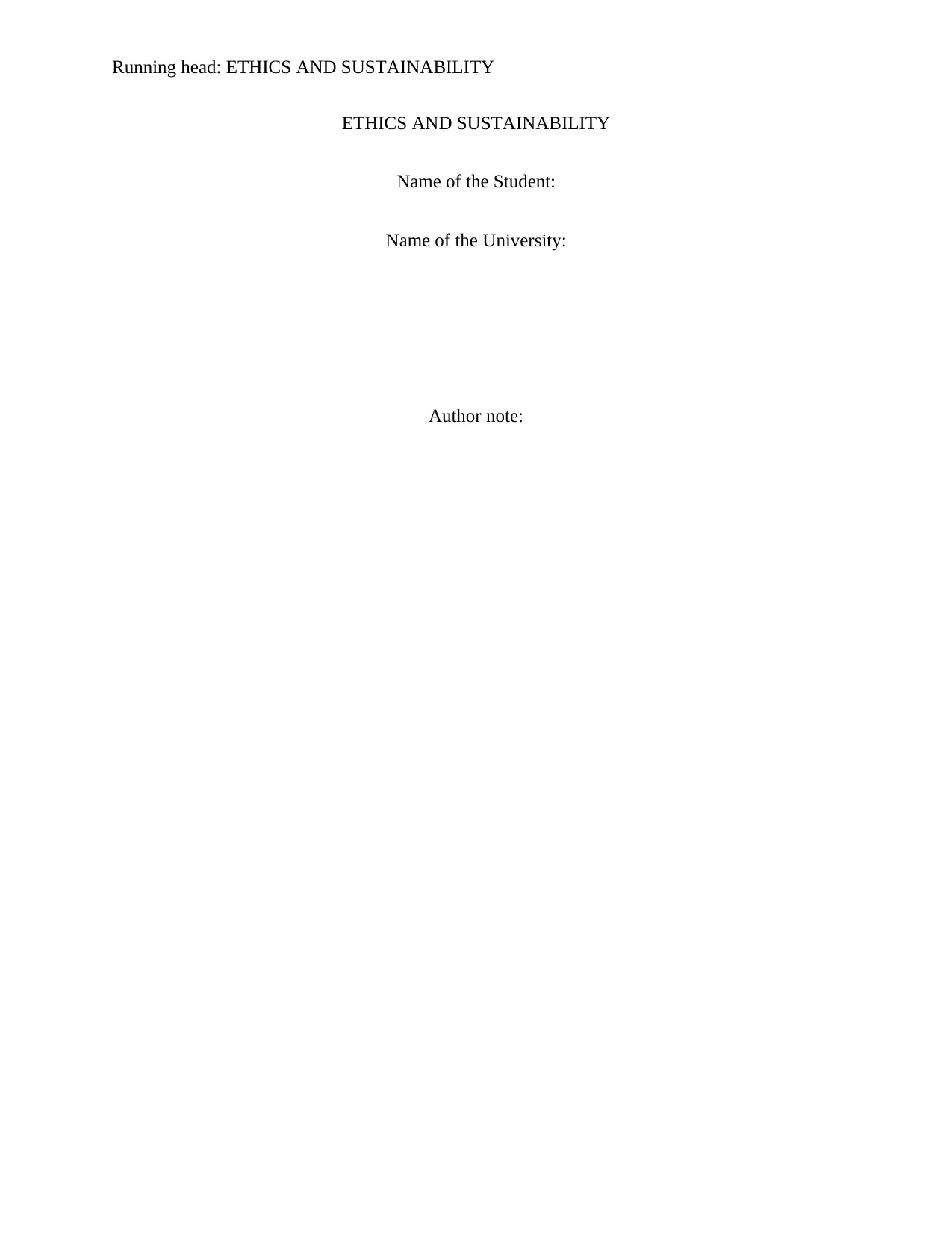
Running head: ETHICS AND SUSTAINABILITY
ETHICS AND SUSTAINABILITY
Name of the Student:
Name of the University:
Author note:
ETHICS AND SUSTAINABILITY
Name of the Student:
Name of the University:
Author note:
Paraphrase This Document
Need a fresh take? Get an instant paraphrase of this document with our AI Paraphraser
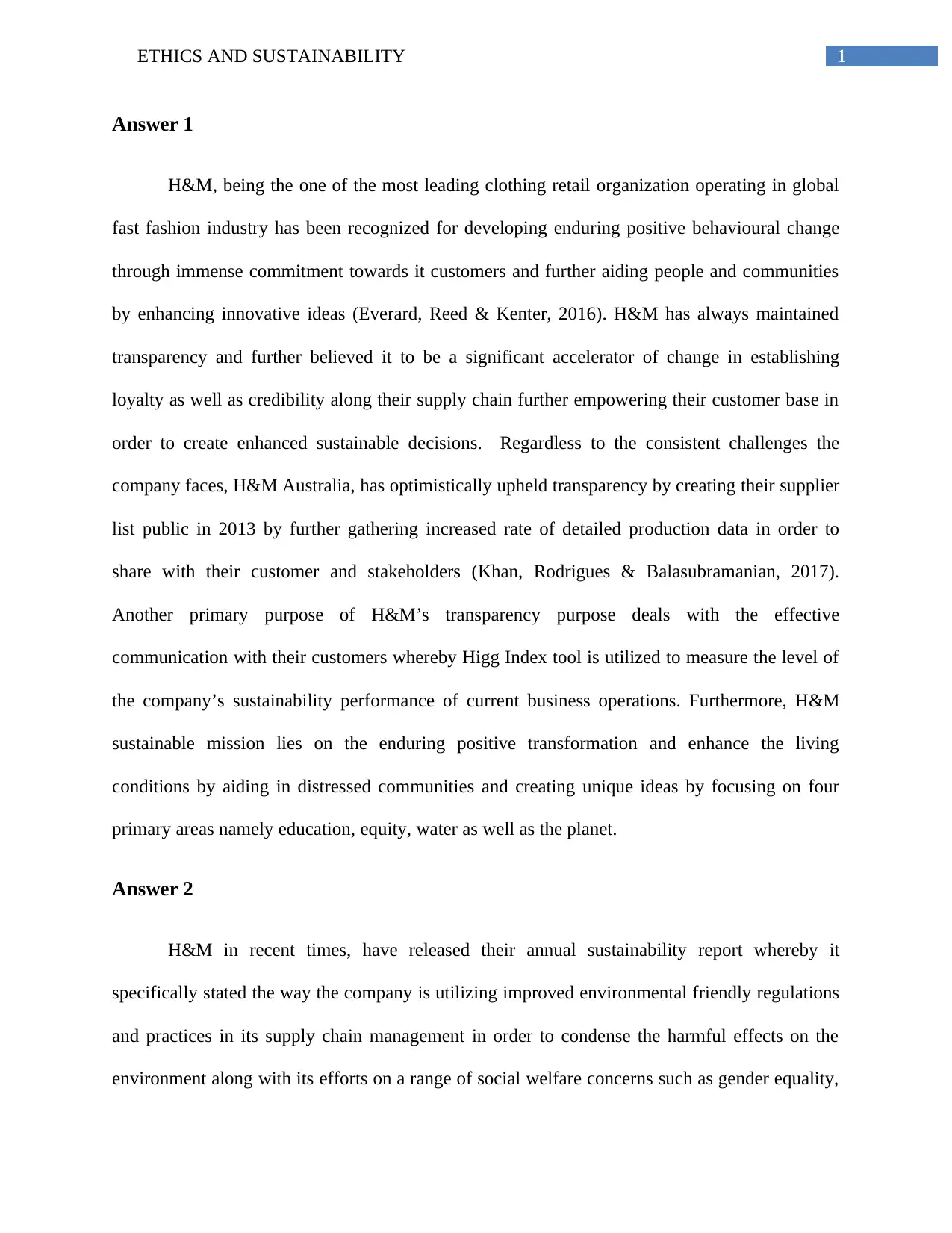
1ETHICS AND SUSTAINABILITY
Answer 1
H&M, being the one of the most leading clothing retail organization operating in global
fast fashion industry has been recognized for developing enduring positive behavioural change
through immense commitment towards it customers and further aiding people and communities
by enhancing innovative ideas (Everard, Reed & Kenter, 2016). H&M has always maintained
transparency and further believed it to be a significant accelerator of change in establishing
loyalty as well as credibility along their supply chain further empowering their customer base in
order to create enhanced sustainable decisions. Regardless to the consistent challenges the
company faces, H&M Australia, has optimistically upheld transparency by creating their supplier
list public in 2013 by further gathering increased rate of detailed production data in order to
share with their customer and stakeholders (Khan, Rodrigues & Balasubramanian, 2017).
Another primary purpose of H&M’s transparency purpose deals with the effective
communication with their customers whereby Higg Index tool is utilized to measure the level of
the company’s sustainability performance of current business operations. Furthermore, H&M
sustainable mission lies on the enduring positive transformation and enhance the living
conditions by aiding in distressed communities and creating unique ideas by focusing on four
primary areas namely education, equity, water as well as the planet.
Answer 2
H&M in recent times, have released their annual sustainability report whereby it
specifically stated the way the company is utilizing improved environmental friendly regulations
and practices in its supply chain management in order to condense the harmful effects on the
environment along with its efforts on a range of social welfare concerns such as gender equality,
Answer 1
H&M, being the one of the most leading clothing retail organization operating in global
fast fashion industry has been recognized for developing enduring positive behavioural change
through immense commitment towards it customers and further aiding people and communities
by enhancing innovative ideas (Everard, Reed & Kenter, 2016). H&M has always maintained
transparency and further believed it to be a significant accelerator of change in establishing
loyalty as well as credibility along their supply chain further empowering their customer base in
order to create enhanced sustainable decisions. Regardless to the consistent challenges the
company faces, H&M Australia, has optimistically upheld transparency by creating their supplier
list public in 2013 by further gathering increased rate of detailed production data in order to
share with their customer and stakeholders (Khan, Rodrigues & Balasubramanian, 2017).
Another primary purpose of H&M’s transparency purpose deals with the effective
communication with their customers whereby Higg Index tool is utilized to measure the level of
the company’s sustainability performance of current business operations. Furthermore, H&M
sustainable mission lies on the enduring positive transformation and enhance the living
conditions by aiding in distressed communities and creating unique ideas by focusing on four
primary areas namely education, equity, water as well as the planet.
Answer 2
H&M in recent times, have released their annual sustainability report whereby it
specifically stated the way the company is utilizing improved environmental friendly regulations
and practices in its supply chain management in order to condense the harmful effects on the
environment along with its efforts on a range of social welfare concerns such as gender equality,
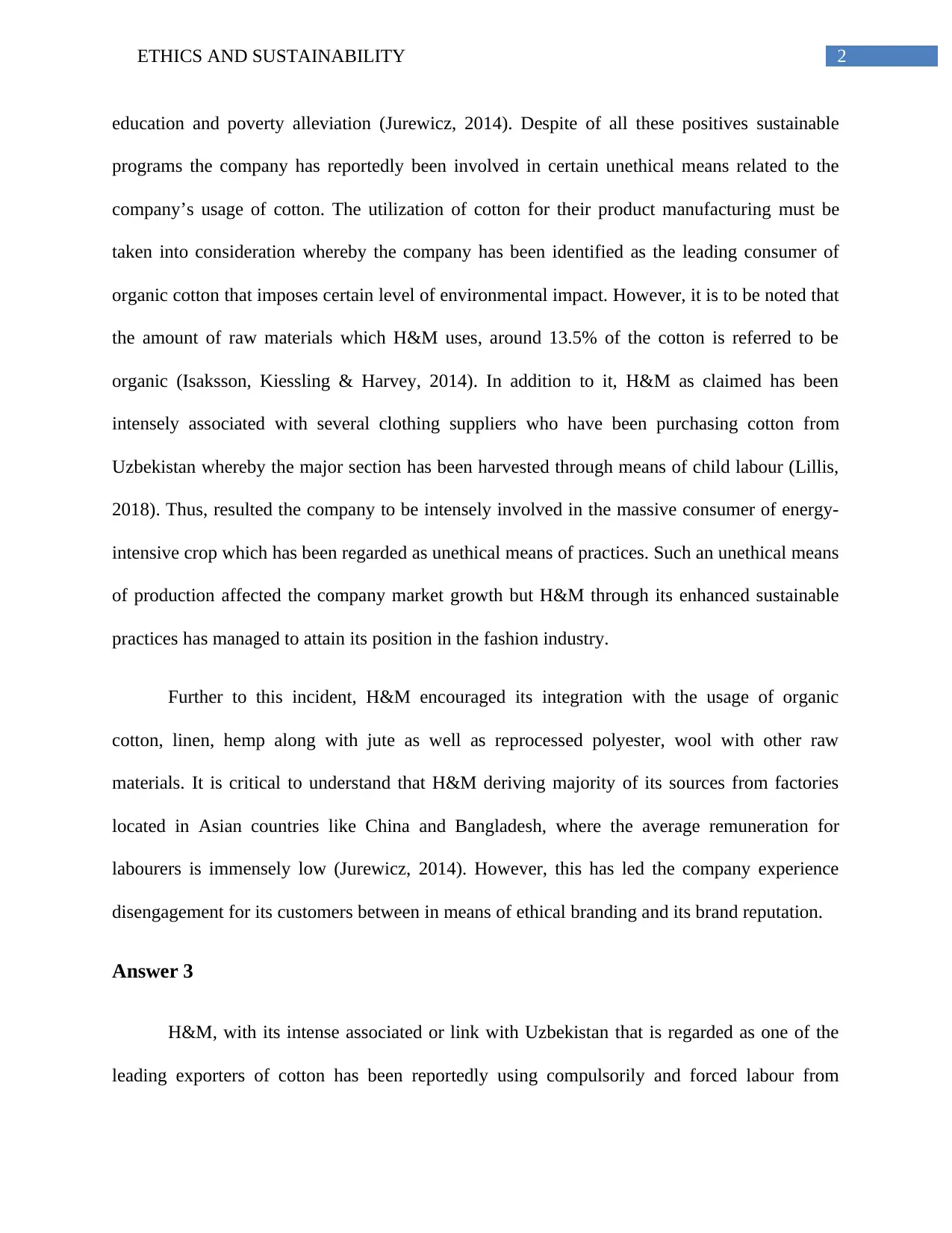
2ETHICS AND SUSTAINABILITY
education and poverty alleviation (Jurewicz, 2014). Despite of all these positives sustainable
programs the company has reportedly been involved in certain unethical means related to the
company’s usage of cotton. The utilization of cotton for their product manufacturing must be
taken into consideration whereby the company has been identified as the leading consumer of
organic cotton that imposes certain level of environmental impact. However, it is to be noted that
the amount of raw materials which H&M uses, around 13.5% of the cotton is referred to be
organic (Isaksson, Kiessling & Harvey, 2014). In addition to it, H&M as claimed has been
intensely associated with several clothing suppliers who have been purchasing cotton from
Uzbekistan whereby the major section has been harvested through means of child labour (Lillis,
2018). Thus, resulted the company to be intensely involved in the massive consumer of energy-
intensive crop which has been regarded as unethical means of practices. Such an unethical means
of production affected the company market growth but H&M through its enhanced sustainable
practices has managed to attain its position in the fashion industry.
Further to this incident, H&M encouraged its integration with the usage of organic
cotton, linen, hemp along with jute as well as reprocessed polyester, wool with other raw
materials. It is critical to understand that H&M deriving majority of its sources from factories
located in Asian countries like China and Bangladesh, where the average remuneration for
labourers is immensely low (Jurewicz, 2014). However, this has led the company experience
disengagement for its customers between in means of ethical branding and its brand reputation.
Answer 3
H&M, with its intense associated or link with Uzbekistan that is regarded as one of the
leading exporters of cotton has been reportedly using compulsorily and forced labour from
education and poverty alleviation (Jurewicz, 2014). Despite of all these positives sustainable
programs the company has reportedly been involved in certain unethical means related to the
company’s usage of cotton. The utilization of cotton for their product manufacturing must be
taken into consideration whereby the company has been identified as the leading consumer of
organic cotton that imposes certain level of environmental impact. However, it is to be noted that
the amount of raw materials which H&M uses, around 13.5% of the cotton is referred to be
organic (Isaksson, Kiessling & Harvey, 2014). In addition to it, H&M as claimed has been
intensely associated with several clothing suppliers who have been purchasing cotton from
Uzbekistan whereby the major section has been harvested through means of child labour (Lillis,
2018). Thus, resulted the company to be intensely involved in the massive consumer of energy-
intensive crop which has been regarded as unethical means of practices. Such an unethical means
of production affected the company market growth but H&M through its enhanced sustainable
practices has managed to attain its position in the fashion industry.
Further to this incident, H&M encouraged its integration with the usage of organic
cotton, linen, hemp along with jute as well as reprocessed polyester, wool with other raw
materials. It is critical to understand that H&M deriving majority of its sources from factories
located in Asian countries like China and Bangladesh, where the average remuneration for
labourers is immensely low (Jurewicz, 2014). However, this has led the company experience
disengagement for its customers between in means of ethical branding and its brand reputation.
Answer 3
H&M, with its intense associated or link with Uzbekistan that is regarded as one of the
leading exporters of cotton has been reportedly using compulsorily and forced labour from
⊘ This is a preview!⊘
Do you want full access?
Subscribe today to unlock all pages.

Trusted by 1+ million students worldwide
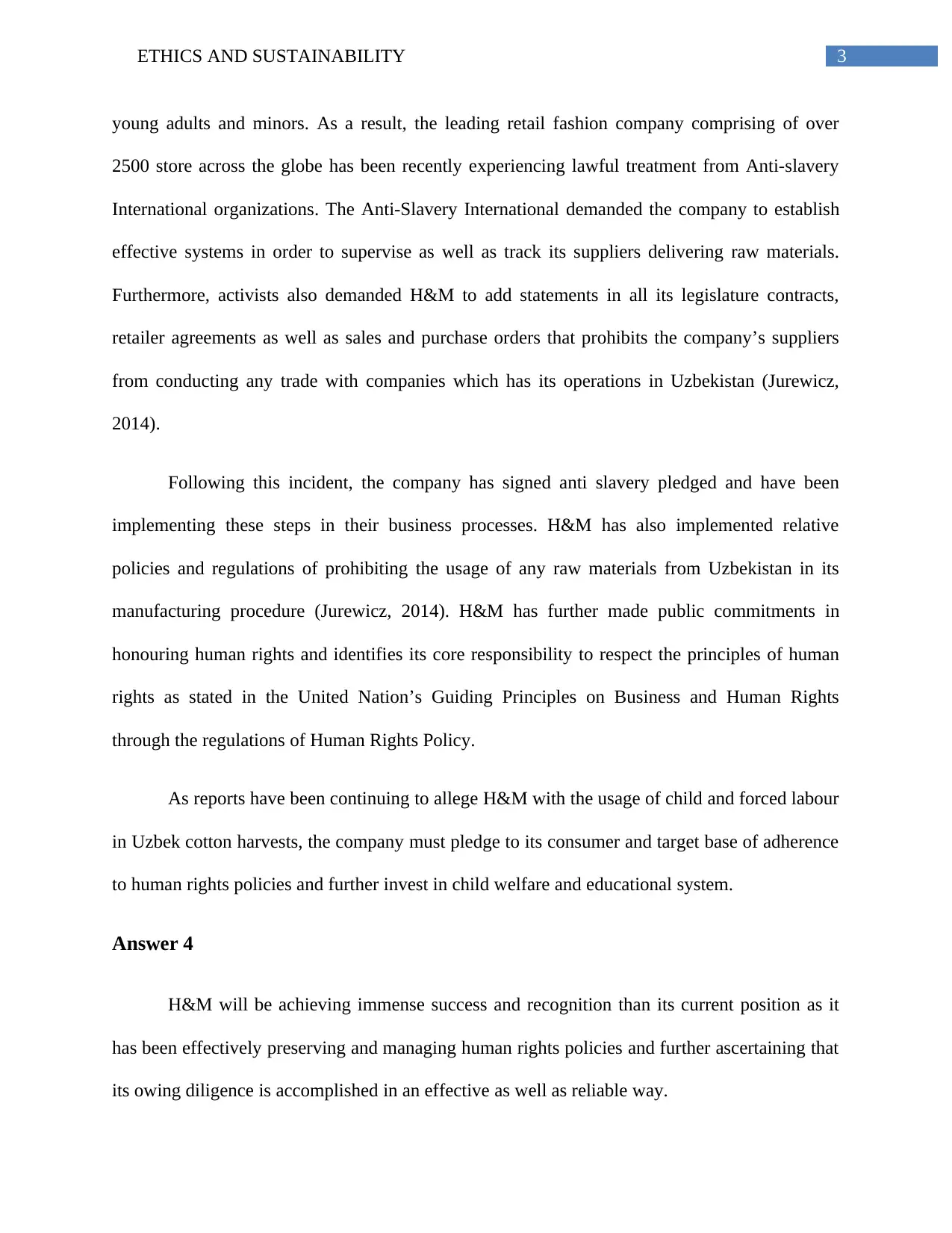
3ETHICS AND SUSTAINABILITY
young adults and minors. As a result, the leading retail fashion company comprising of over
2500 store across the globe has been recently experiencing lawful treatment from Anti-slavery
International organizations. The Anti-Slavery International demanded the company to establish
effective systems in order to supervise as well as track its suppliers delivering raw materials.
Furthermore, activists also demanded H&M to add statements in all its legislature contracts,
retailer agreements as well as sales and purchase orders that prohibits the company’s suppliers
from conducting any trade with companies which has its operations in Uzbekistan (Jurewicz,
2014).
Following this incident, the company has signed anti slavery pledged and have been
implementing these steps in their business processes. H&M has also implemented relative
policies and regulations of prohibiting the usage of any raw materials from Uzbekistan in its
manufacturing procedure (Jurewicz, 2014). H&M has further made public commitments in
honouring human rights and identifies its core responsibility to respect the principles of human
rights as stated in the United Nation’s Guiding Principles on Business and Human Rights
through the regulations of Human Rights Policy.
As reports have been continuing to allege H&M with the usage of child and forced labour
in Uzbek cotton harvests, the company must pledge to its consumer and target base of adherence
to human rights policies and further invest in child welfare and educational system.
Answer 4
H&M will be achieving immense success and recognition than its current position as it
has been effectively preserving and managing human rights policies and further ascertaining that
its owing diligence is accomplished in an effective as well as reliable way.
young adults and minors. As a result, the leading retail fashion company comprising of over
2500 store across the globe has been recently experiencing lawful treatment from Anti-slavery
International organizations. The Anti-Slavery International demanded the company to establish
effective systems in order to supervise as well as track its suppliers delivering raw materials.
Furthermore, activists also demanded H&M to add statements in all its legislature contracts,
retailer agreements as well as sales and purchase orders that prohibits the company’s suppliers
from conducting any trade with companies which has its operations in Uzbekistan (Jurewicz,
2014).
Following this incident, the company has signed anti slavery pledged and have been
implementing these steps in their business processes. H&M has also implemented relative
policies and regulations of prohibiting the usage of any raw materials from Uzbekistan in its
manufacturing procedure (Jurewicz, 2014). H&M has further made public commitments in
honouring human rights and identifies its core responsibility to respect the principles of human
rights as stated in the United Nation’s Guiding Principles on Business and Human Rights
through the regulations of Human Rights Policy.
As reports have been continuing to allege H&M with the usage of child and forced labour
in Uzbek cotton harvests, the company must pledge to its consumer and target base of adherence
to human rights policies and further invest in child welfare and educational system.
Answer 4
H&M will be achieving immense success and recognition than its current position as it
has been effectively preserving and managing human rights policies and further ascertaining that
its owing diligence is accomplished in an effective as well as reliable way.
Paraphrase This Document
Need a fresh take? Get an instant paraphrase of this document with our AI Paraphraser
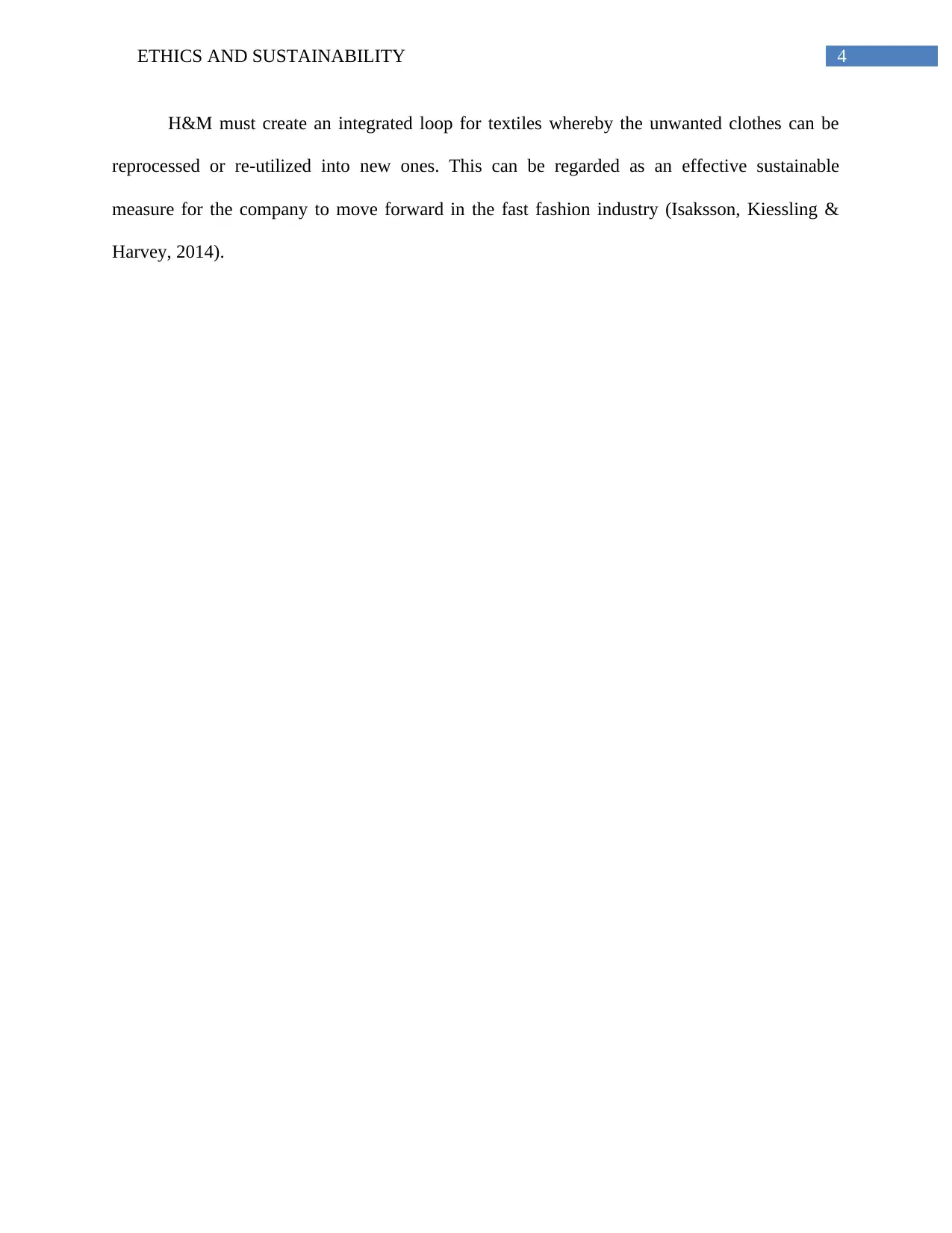
4ETHICS AND SUSTAINABILITY
H&M must create an integrated loop for textiles whereby the unwanted clothes can be
reprocessed or re-utilized into new ones. This can be regarded as an effective sustainable
measure for the company to move forward in the fast fashion industry (Isaksson, Kiessling &
Harvey, 2014).
H&M must create an integrated loop for textiles whereby the unwanted clothes can be
reprocessed or re-utilized into new ones. This can be regarded as an effective sustainable
measure for the company to move forward in the fast fashion industry (Isaksson, Kiessling &
Harvey, 2014).
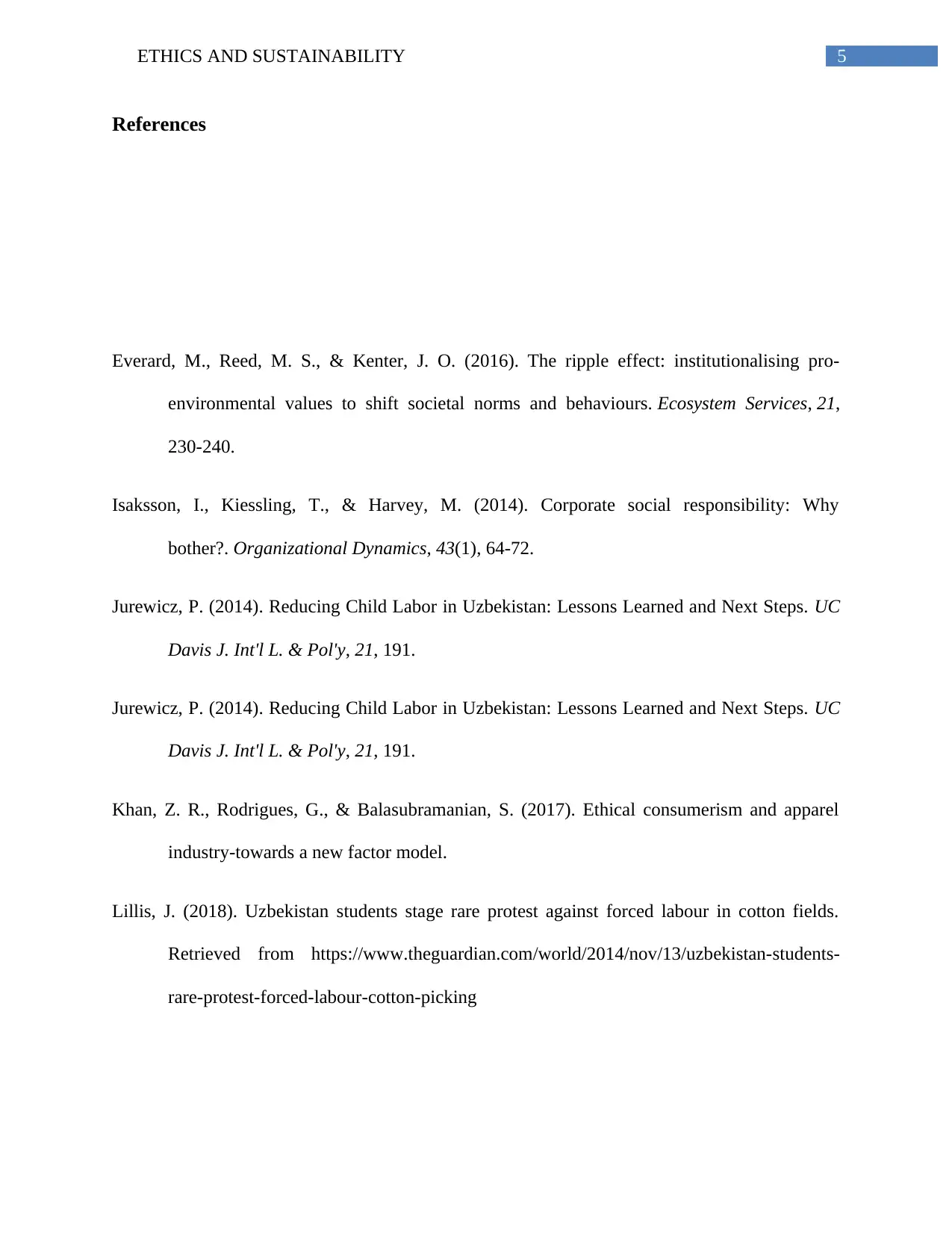
5ETHICS AND SUSTAINABILITY
References
Everard, M., Reed, M. S., & Kenter, J. O. (2016). The ripple effect: institutionalising pro-
environmental values to shift societal norms and behaviours. Ecosystem Services, 21,
230-240.
Isaksson, I., Kiessling, T., & Harvey, M. (2014). Corporate social responsibility: Why
bother?. Organizational Dynamics, 43(1), 64-72.
Jurewicz, P. (2014). Reducing Child Labor in Uzbekistan: Lessons Learned and Next Steps. UC
Davis J. Int'l L. & Pol'y, 21, 191.
Jurewicz, P. (2014). Reducing Child Labor in Uzbekistan: Lessons Learned and Next Steps. UC
Davis J. Int'l L. & Pol'y, 21, 191.
Khan, Z. R., Rodrigues, G., & Balasubramanian, S. (2017). Ethical consumerism and apparel
industry-towards a new factor model.
Lillis, J. (2018). Uzbekistan students stage rare protest against forced labour in cotton fields.
Retrieved from https://www.theguardian.com/world/2014/nov/13/uzbekistan-students-
rare-protest-forced-labour-cotton-picking
References
Everard, M., Reed, M. S., & Kenter, J. O. (2016). The ripple effect: institutionalising pro-
environmental values to shift societal norms and behaviours. Ecosystem Services, 21,
230-240.
Isaksson, I., Kiessling, T., & Harvey, M. (2014). Corporate social responsibility: Why
bother?. Organizational Dynamics, 43(1), 64-72.
Jurewicz, P. (2014). Reducing Child Labor in Uzbekistan: Lessons Learned and Next Steps. UC
Davis J. Int'l L. & Pol'y, 21, 191.
Jurewicz, P. (2014). Reducing Child Labor in Uzbekistan: Lessons Learned and Next Steps. UC
Davis J. Int'l L. & Pol'y, 21, 191.
Khan, Z. R., Rodrigues, G., & Balasubramanian, S. (2017). Ethical consumerism and apparel
industry-towards a new factor model.
Lillis, J. (2018). Uzbekistan students stage rare protest against forced labour in cotton fields.
Retrieved from https://www.theguardian.com/world/2014/nov/13/uzbekistan-students-
rare-protest-forced-labour-cotton-picking
⊘ This is a preview!⊘
Do you want full access?
Subscribe today to unlock all pages.

Trusted by 1+ million students worldwide
1 out of 6
Related Documents
Your All-in-One AI-Powered Toolkit for Academic Success.
+13062052269
info@desklib.com
Available 24*7 on WhatsApp / Email
![[object Object]](/_next/static/media/star-bottom.7253800d.svg)
Unlock your academic potential
Copyright © 2020–2025 A2Z Services. All Rights Reserved. Developed and managed by ZUCOL.





